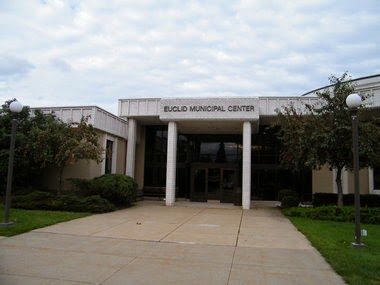Marcus Epps of Euclid
dismantleEuclid
dismantle
According to Ch 19, Council
Prez Holzheimer-Gail justified the move with, "We need to move our city forward, look into doing things a little more progressive. The old way of doing business is not going to help us do things better." As part of the agreement, the council president says the current dispatchers, roughly a dozen, will not be laid off, but absorbed by Chagrin Valley. Making the move at this time also allows the city to take advantage of grant money to upgrade radio equipment for both police and fire.
"Our equipment is aging and reaching the end of its useful life, so that would be a cost the city would have to incur if we stayed on our own. And most cities like ours are struggling for tax dollars," explained Holzheimer Gail. (posted Nov 4th)
Ward 7 Councilman Pat Delaney isn't so sure. He told Ch. 19, "We could look at garbage collection, we could look at recreation, look at many other things. But when it comes to 911, that could be a sacred cow.... When it comes to the citizens front line of protecting them, there is no margin for error. With this there will be a learning curve. And it's one of those votes on City Council when I hope I'm wrong." Delaney says residents and others opposed would rather see regionalization in other departments.
The legislation narrowly passed 5-4. Voting FOR were Holzheimer-Gail (P), Caviness (1), Scarniench (2), Jones (3) and Jarosz (4). Voting AGAINST were McLaughlin (5), Delaney (6), Langman (7) and Gorshe (8).
With the vote so close, Marcus Epps is taking action. He is circulating a Referendum Petition to overturn Council's vote, put it on hold and let the voters decide.
According to the City Charter Article III, Section 1B, any non-emergency ordinance passed by Council is subject to referendum. The petition will need around 1,500 valid signatures (10% of the 2010 votes cast for Governor). Epps has until Dec 2nd - 30 days from passage to gathem them and will present the petitions to Finance Director Malone.
Council can if enough signatures are acquired to convince them, overturn its own legislation and so avoid the measure being put on the ballot.
Last week Epps sent an email that he will hold a public meeting at Euclid Library this Wed Nov 19th at 7:15pm. Current dispatchers and Council members are expected to be there. It's a great opportunity for you to hear the arguments and voice your opinion. Petitions for signing or gathering signatures will be available. You can read the email here.
It should be an interesting meeting.
"Our equipment is aging and reaching the end of its useful life, so that would be a cost the city would have to incur if we stayed on our own. And most cities like ours are struggling for tax dollars," explained Holzheimer Gail. (posted Nov 4th)
Ward 7 Councilman Pat Delaney isn't so sure. He told Ch. 19, "We could look at garbage collection, we could look at recreation, look at many other things. But when it comes to 911, that could be a sacred cow.... When it comes to the citizens front line of protecting them, there is no margin for error. With this there will be a learning curve. And it's one of those votes on City Council when I hope I'm wrong." Delaney says residents and others opposed would rather see regionalization in other departments.
The legislation narrowly passed 5-4. Voting FOR were Holzheimer-Gail (P), Caviness (1), Scarniench (2), Jones (3) and Jarosz (4). Voting AGAINST were McLaughlin (5), Delaney (6), Langman (7) and Gorshe (8).
With the vote so close, Marcus Epps is taking action. He is circulating a Referendum Petition to overturn Council's vote, put it on hold and let the voters decide.
According to the City Charter Article III, Section 1B, any non-emergency ordinance passed by Council is subject to referendum. The petition will need around 1,500 valid signatures (10% of the 2010 votes cast for Governor). Epps has until Dec 2nd - 30 days from passage to gathem them and will present the petitions to Finance Director Malone.
Council can if enough signatures are acquired to convince them, overturn its own legislation and so avoid the measure being put on the ballot.
Last week Epps sent an email that he will hold a public meeting at Euclid Library this Wed Nov 19th at 7:15pm. Current dispatchers and Council members are expected to be there. It's a great opportunity for you to hear the arguments and voice your opinion. Petitions for signing or gathering signatures will be available. You can read the email here.
It should be an interesting meeting.


